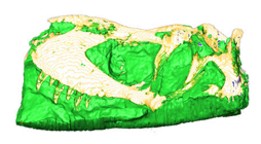Taphonomy
University of Arkansas at Little Rock Paleobiology ERSC 3360
Taphonomy
The term taphonomy was first coined by Ivan Efromov is 1940 and means, "laws of burial". Taphonomy is the study of the processes of decay and burial leading to fossilization, as well as the biases and influences that affect interpretation of the fossil record. Thus, taphonomy is the study of everything that happens to organisms and the communities they form from the time they die to the time they are collected and studied.
Taphonomy can be broken into two main categories, biostratinomy and diagenesis. Biostratinomy covers aspects of death and decay to the time the remains enter the geologic record, although some separate necrolysis, the initial decompositional stages, into its own category. Diagenesis covers long term processes that occur after burial. There are several ways organisms can become fossilized. These include remaining as unaltered remains, recystallization, permineralization, replacement, molding and casting, annd carbonization, among others.
There are several taphonomic indicators, each can tell us something about the conditions in which the remains of an organism were deposited after death. They can also tell us about the environment an organism may have been transported by or to upon death. These indicators are:
Abrasion-When the bones or skeleton of an organism are worn down. This is usually due to the movement of water such as wave action or a strong current, but can sometimes mean a bone or skeleton was exposed to the erosional forces of weather. Abrasion removes surface details, and fragments become rounded. Articulation-When skeletal remains are found intact. It can be an indicator of rapid burial or deposition in a very calm environment. Bioerosion-This indicates that an organism was eaten away at or otherwise degradated by another organism. Examples of this include grazing or boring. Bioerosion is sometimes detrimental because it can erase information from the fossil record. On the other hand it can leave behind trace fossils which are useful in gaining additional information about an environment or ecosystem. Dissolution-This occurs when changes in pH, temperature, or pCO2 in the surrounding water a bone or skeleton was deposited in causes it to dissolve. This is very common for Calcium Carbonate skeletons, however it can occur with siliceous skeletons.Siliceous skeletons can also be dissolved in plain, everyday seawater. Encrustation-This occurs when other organisms attach themselves or grow onto skeletal remains. This can be specific to a particular type of environment Fragmentation-This is when bones or skeletal remains become broken or fragmented. This can occur in high energy aquatic environments such as rivers or oceans, or by scavenging or predation by other organisms. Wave action may cause such extensive fragmentation that everthing is reduced to fine grained sand. Rounding-When the sharp or protruding edges of bone become broken off or otherwise worn down. This can occur for a number of reasons such as wave action, current, dissolution, abrasion, and bioerosion. Rounding helps to estimate the time a bone or skeleton was exposed. Orientation-This is the position that remains are found in. This can be used to determine if there was rapid burial of an organism or if it were transported to a different area upon death, such as in a high energy aquatic environment. As an example, if a skeleton were found intact in a life position, it is a pretty good indicator of rapid burial. Disarticulated-when skeletons are sparated into their component parts. Happens after an organism dies and the scavening or decay of connective tissues that hold the skeleton together. This process can occur within a few hours of the organisms death.
Chemical changes during diagenesis
Carbonates - Many organisms produce shells of a carbonate mineral known as Aragonite. Aragonite shares the formula CaCO3 with Calcite, but its crystal structure is significantly less stable under normal conditions. As a result, one of the most common chemical changes which occurs during diagenesis is the recrystalization of aragonite shells into calcite. Bacterial processes common to black shale deposits also encourage the formation of carbonate concretions around fossils.
Pyrite - Pyrite (FeS2), which is produced by microbial processes, is often found replacing dissolved minerals in fossils.
Phosphate - Phosphate is found in the bodies of many organisms and can be released as an ion during the decay process. These released phosphate ions can form apatite which can replace the original mineral, or it can simply form deposits which destroy the original form of the fossil but none the less indicate its former presence.
| Work in progress, expect frequent changes. Help and feedback is welcome. See discussion page. |
